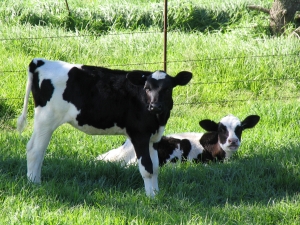Apologies for the slightly dodge agrarian pun in the subject line.

Reading the headline for this, however, has had me hanging onto my chair in hysterics for the last 5 minutes (a long time, believe me). And, given the extent to which kiwis care about cows (and their climbing numbers here), it was, I thought, something to be shared immediately.
So, on to details!
The paper in question aims to explain, and predict, how it is that cows lie down/stand up* in synchrony. Something, apparently, that they do, space and resources allowing**. Now, synchronous behaviour amongst beasties (including bacteria) is hardly unusual, but no one had attempted it with beasties of the bovine persuasion before, and so this behaviour wasn’t well understood.
And how have they achieved it? Simple. They treated cows like oscillators***. Oscillators, as the name implies, oscillate between two states. On an ongoing basis (think sine wave). If applying this logic to our dairylicious friends, it means treating cows as either standing up, or lying down, and doing this in cycles. And they are then coupled, which doesn’t necessarily involve watching them do, um, documentary type things, but instead means that they are more likely to stand up or lie down depending on the behaviour of the cows around them. Or, to put it another way, the authors took their single cow equations, turned them into coupled cow equations, and then used those to construct networks of interacting cows (herd equations).
And they put in place some assumptions. For example, they posited that a cow watching others around it standing and eating, might feel peckish too (in the same way that, no matter how unhungry you are, you will still nick someone’s chips). Conversely, it might feel compelled to have a lie down when its herd-buddies do. Certainly, it assumes that space is unlimited - i.e the cows are living a kiwi lifestyle, not an intensive-farming lifestyle. The authors were at pains to point out, however, that these constraints are not necessary, and that it would be interesting to consider other options, as well as comparing the model’s predictions to real behaviour (apparently such observations are under way).
Using the constraints mentioned, however, they found that high degrees of herd synchrony don’t necessarily accompany strong coupling. Certainly one can see the benefits inherent in an entire herd not, for example lying down (the better to see predators, my dear).
Happily, the model could also be used to understand synchrony in other ruminants. Hooray :)
And, as a final note****, the authors end with:
Milking these ideas as much as possible should prove to be very insightful from both theoretical and practical perspectives.
Indeed.
Anyone have any good cow herd stories to share? Or want to go play in fields with herds of them testing the maths?
———————————
As usual, there’s a fun arxiv article on the subject, and the paper can be read here. The article does contain the fascinating tidbit that happy cows are more likely to act synchronously. Hmmmm. It’s certainly a very clear way of measuring their quality of life, albeit an amusing one.
* I blame this hyperlink on a friend to whom I am introducing Radiohead (yes, gasp). It means I have ol’ Thom stuck on the brain at the moment.
** Not being agrarian, this was news to me. Imagine my embarrassment to find I was not in possession of a well-known fact. They stand to feed, and lie to ruminate (which latter phrase sounds suspiciously philosophical). Both stages are necessary.
*** A piecewise affine dynamical system. If you know what that is, I am most impressed. I have no idea.
**** For another fine example of people being humorous, see my post on teapots and fluidic dynamics.
UPDATE: I just noticed another fine piece of sciency humour (in the arxiv article):
On the other hand, cows are so highly bred that it would hardly be a surprise if they had lost the ability to protect themselves from natural predators. That’s a topic ripe for rumination by a suitably interested PhD student.
* head smack *
Pingback: Tweets that mention The first mathematical model for cow behaviour | misc.ience -- Topsy.com()